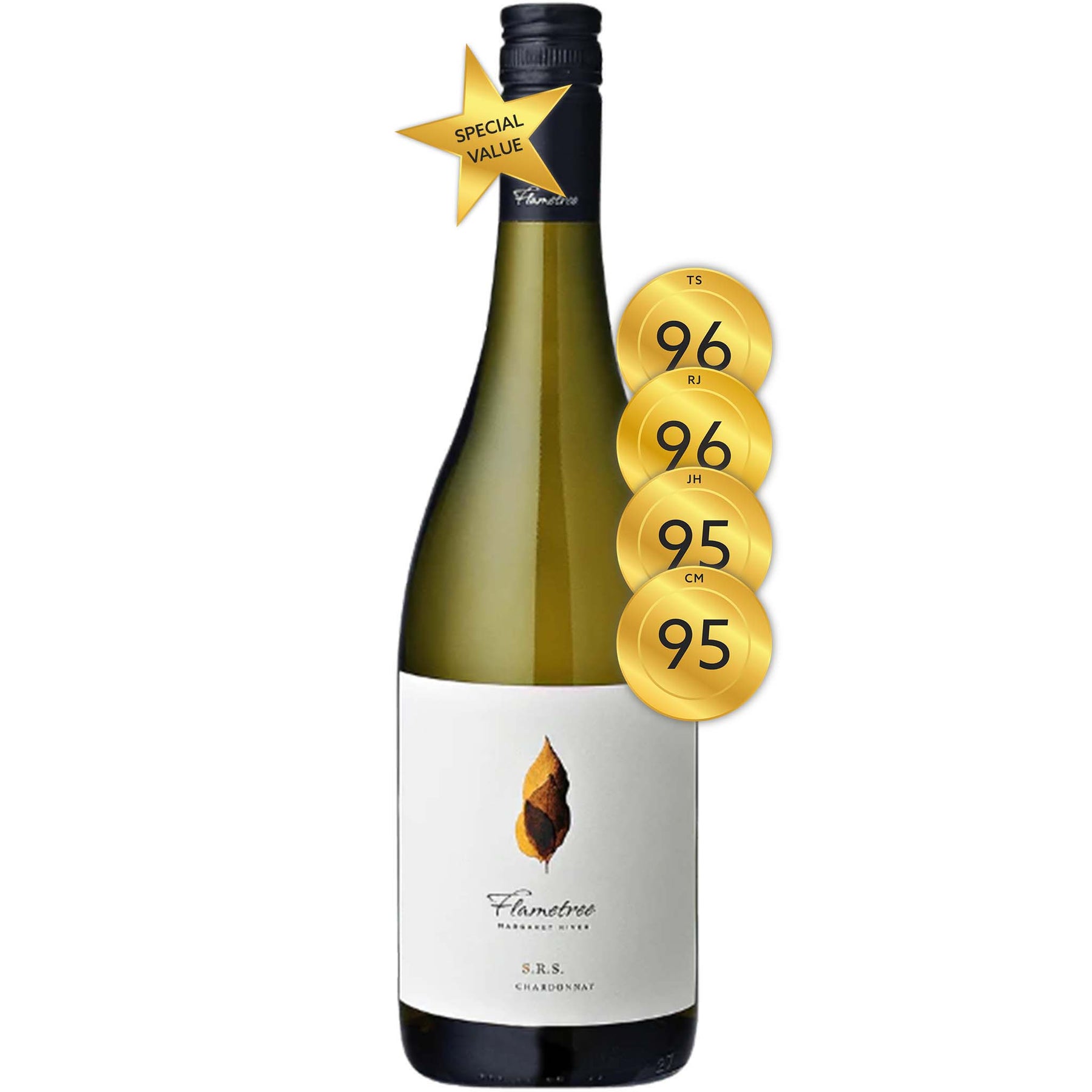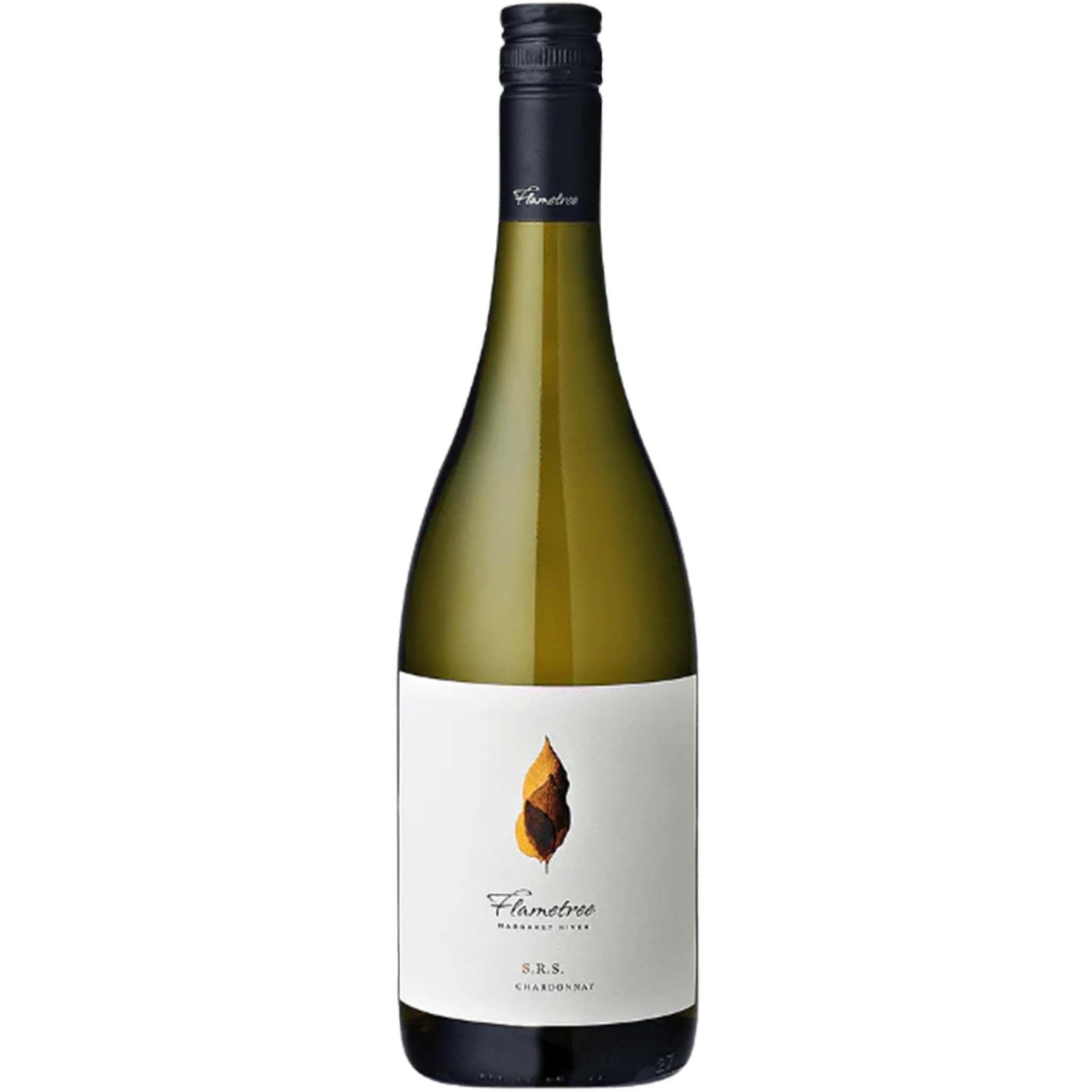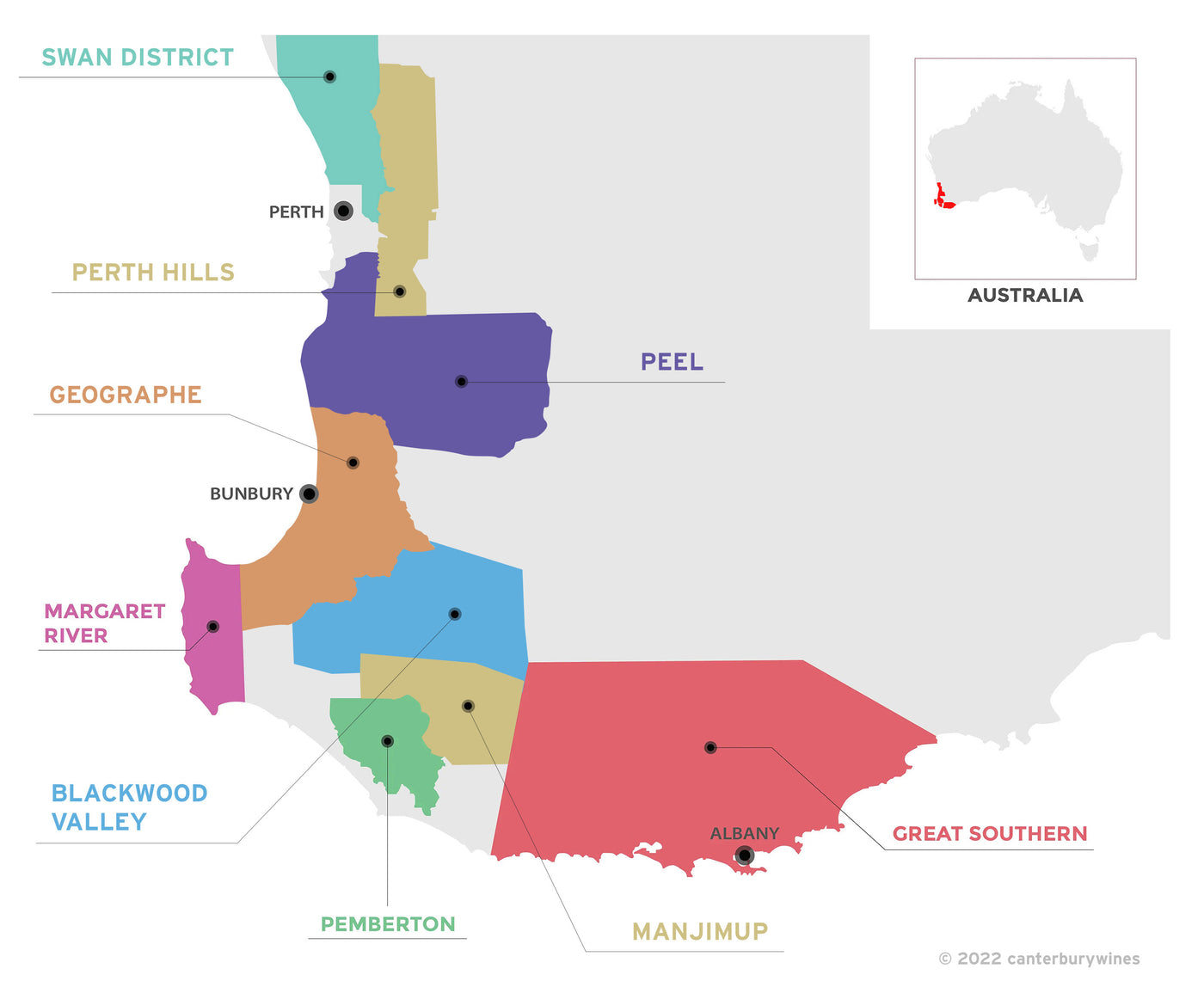

Flametree SRS Wallcliffe Chardonnay 2012
Style: White Wine
Closure: Screwcap
Flametree SRS Wallcliffe Chardonnay 2012
Warehouse
34 Redland Drive
Vermont VIC 3133
Australia
Critic Score: 96
Alcohol: 13.0%
Size: 750 ml
Drink by: Now
Flametree selects iconic quality fruit from specific vineyards across the region to make the multiple award-winning SRS (Sub Regional Series) range. The SRS Chardonnay is Flametree's flagship wine. Fruit for the 20124 vintage was sourced from a single block on Steven's Road in the Wallcliffe sub-region planted to the Gin Gin clone. The old, low yielding vines cropped at around 4 tonnes per hectare. The wine was barrel fermented in French oak, 40% new, the remainder being two and three-year seasoned wood.
"It's a cracking wine. Margaret River chardonnay at its complex best. It starts off powerful but then angles down to a long, finely-textured finish. There's some funk, some flint, some grapefruit, some tinniness and some tropical notes. Smoky and matchsticky, but with bright, pristine fruit lighting up the palate. Great finesse, interest, length and drinkability. For all its overtness it's a juicy wine; it compels you to reach for more." Campbell Mattinson
"The 2012 is the third vintage produced under the Flametree SRS label. The 2012 SRS Chardonnay is a more powerfully built wine than the previous two vintages and shows the fruit flavour synonymous with the great Margaret River Chardonnays. Plenty of dried pear, citrus and stone fruit flavours are combined with savoury notes from the wild solids ferment. These fruit flavours are supported by subtle French oak. The SRS Chardonnay has some complex sulphides in the struck match or popcorn spectrum. These sulphides give the wine a lovely savoury or saline character that complements modern food flavours particularly well. After 10 months in the finest French oak the wine was fined with milk, filtered and bottled in January 2013." Flametree
Expert reviews
"Flametree is now securely in Margaret River's A-league of Chardonnay and this wine confirms it. Warm season generosity is perfectly offset by energetic malic acidity and solidsy, wild ferment texture." Tyson Stelzer, Wine Taste - 96 points
"A very modern expression of chardonnay, though one which retains its distinctive Margaret River roots. Sourced from the southern Margaret River region. It is complex and restrained with dried fruit aromas of grapefruit and pear. The medium-weight palate is deep grapefruit and melon flavours with an oak infusion that works beautifully." Ray Jordan, Drinks Trade – 96 points
"Bright green-straw; the intensity of the wine comes from the southern, coolest part of Margaret River; here length is more important than the depth of Margaret River chardonnay as a whole; the flavour spectrum and mouthfeel are also distinctly different, firmly tied to grapefruit/citrus. Drink by 2022." James Halliday, Halliday Wine Companion - 95 points and Special Value Wine ★
"It's a cracking wine. Margaret River chardonnay at its complex best. It's wild fermented and does not go through malo. It's another Margaret River chardonnay going down the 'turbidity' route. Grown in the Wallcliffe sub-region. It starts off powerful but then angles down to a long, finely-textured finish. There's some funk, some flint, some grapefruit, some tinniness and some tropical notes. Smoky and matchsticky, but with bright, pristine fruit lighting up the palate. Great finesse, interest, length and drinkability. For all its overtness it's a juicy wine; it compels you to reach for more. Drink: 2014-2020+." Campbell Mattinson, The Wine Front - 95 points
Awards
Special Value Wine – Halliday Wine Companion ★
Cliff Royle

Cliff Royle has been making premium wines in the Margaret River region for well over two decades. He came to Flametree Wines in 2009 after twelve years as Chief Winemaker at Voyager Estate. "Winemaker Cliff Royle is regarded by critics as one of the most gifted winemakers of his generation." Andrew Caillard MW
Royle has a soft spot for Chardonnay. "Chardonnay makes the greatest white wines in the world," he says. "Top White Burgundy and Blanc de Blanc Champagnes are the benchmark to which we can all learn valuable lessons with regard to structure, balance and complexity. Am I trying to make these wines? No. I’m learning how to make Margaret River wines more interesting whilst keeping great examples of these wines in the back of my mind. We get so much raw fruit power in Margaret River, I just think we can look harder at making our wines a little less fruit driven whilst more savoury and complex."
His groundbreaking 2002 Voyager chardonnay was one of the first Margaret River chardonnays using grapes that were picked early. Equally importantly, it was not put through a secondary malolactic fermentation, which had long been the norm in the region and continues to be among some producers. The result was a restrained and long-lived wine. Royle says his change of tactic was influenced by conversations with east coast chardonnay gurus Dave Bicknell (from Oakridge) and Tom Carson (now at Yabby Lake), and by the burgundies he's tasted from the Roulot and Pierre-Yves Colin-Morey domaines.
Cliff was awarded Winemaker of the Year by Winestate Magazine in 2003 and was a finalist in the Gourmet Traveller Winemaker of the Year in 2005, to name two of the accolades he has received in his career. In addition, he has been a senior judge at the Royal Melbourne and Perth Wine Shows for a number of years.
The text below is taken from an article titled 'The Brilliance of Flametree Wines' that appeared in London Drinks Guide
Compared to some of the pioneering wineries from the Margaret River industry, Flametree is a relatively young player. However, their wines have achieved acclaim well beyond their age. The winery is committed to producing consistently great wines, all of which champion the fruit of the Margaret River region. At the core of their day to day routine is a team of dedicated individuals who are proud of the place and the wines they make. Heading this team is Cliff Royle, the Chief Winemaker and General Manager. Cliff talks about his time producing quality wines, being a loyal employee of Flametree Wines and how he sees the Australian wine culture progressing in the years to come.
Tell us a little bit about yourself
I have had the pleasure of working in the wine industry for most of my working life, after an initial stint in hospitality. I suppose you'd call me a loyal employee, as I've been at Flametree Wines for 12 years. Before that, I was at Voyager Estate for 12 years. My love for wine has been further enhanced by my travels over the years, and my absolute favourites are Barolos and Burgundies. After vintage, I love nothing more than to head up north, find some sunshine, put some beer on ice and go fishing with old schoolmates. At home in Margaret River, I love that wine brings a family together for meals filled with music, great food and lots of laughter.
According to you, what makes a great wine?
Making great wines starts with great fruit, fruit that can then allow the house style to shine. I follow great producers, not great vintages. Almost everyone can make a great wine in an outstanding vintage. However, the best winemakers always find a way to make quality wines in the context of what the vintage throws at them. I enjoy the challenge of lesser vintages in which you have to pull together all your resources as there is nowhere to hide. This is when your ability to manipulate the fruit and bring its positive features to the forefront count, as do years of experience. I believe that great wines must have perfume, elegance and structure, all integrated into perfect harmony. Most of all, my guide for a great wine is the surprise at how quickly the bottle is emptied!
What would be your typical day at work?
I’m very fortunate that I am employed at Flametree, both as a General Manager and Chief Winemaker. As such, my day to day role is quite complex. At the moment, I’m securing fruit for next year, talking to distributors about allocations, getting wines ready for bottling, and working on a spring release. I am also getting repairs and maintenance completed for the change of season and mapping out the next 6-12 months. Sometimes I’ll be in the winery, tasting and doing allocations all day and on others, I’ll be on a Zoom wine dinner in Singapore. The range of tasks and complexities is endless. Checking in and catching up with our small but very talented team on what’s happening in our backyard and abroad is always fun.
What excites you the most about Flametree Wines?
Our brand takes a very youthful approach. We don't get bogged down by traditions or get trapped by a particular winemaking methodology. The preference is to continue evolving while keeping a core philosophy and retaining a set style guide for just a few of our wines; the rest are always up for review. The fortunate thing is that our customers have come to expect and respect this. They come back for the wines they know and love and to try new styles that we are experimenting with. This flexibility gives us a fresh story and a competitive edge.
What do you consider your flagship wine and why?
Our flagship wine would be the Flametree S.R.S. Wallcliffe Chardonnay. The wine is modern in style and pushes the boundaries on minerality and complexity whilst retaining the underlying Margaret River fruit power that has made the region famous. The wine style is respectful of fruit purity, works well with food, and has the potential to age well. This wine has had huge national and international success and has firmly put Margaret River in the top international Chardonnay conversation. We use hand-picked fruit and large format oak with little to no MLF or lees stirring, looking for an ultimate site and clone purity.
Chardonnay is back in a big way and so it should. There are no greater wines than the white wines made from the Chardonnay grape.
What are some wine trends you're expecting to see?
I can't speak for global trends, but in Australia, there is a growing trend towards 'alternate varietals' (i.e. not the usual big players such as Chardonnay, Cabernet Shiraz, Sauvignon Blanc etc) as well as lighter-style reds. As I mentioned previously, some of these big players are also seeing a shift in style; with Chardonnay becoming more refined and Cabernet less heavily oaked and more fruit-forward.
Lastly, what are you drinking right now?
At the moment I’m pretty obsessed with 2016 Barolo’s, 2018/19 Burgundies, 2019 German Rieslings and the 2018 Margaret River Cabernet Sauvignon. The latter is the best vintage in my 25 years as a winemaker in the Margaret River region.
About the winery
 Established in 2007 by the Towner family, Flametree has quickly become renowned for its award-winning Chardonnay and Cabernet Sauvignon wines; the two hero varietals of Margaret River. Compared to some of the pioneering wineries from the Margaret River industry, Flametree is a relatively young player. However, their wines have achieved acclaim well beyond their age.
Established in 2007 by the Towner family, Flametree has quickly become renowned for its award-winning Chardonnay and Cabernet Sauvignon wines; the two hero varietals of Margaret River. Compared to some of the pioneering wineries from the Margaret River industry, Flametree is a relatively young player. However, their wines have achieved acclaim well beyond their age.
Flametree burst onto the Australian wine scene by winning the prestigious Jimmy Watson Trophy for its first ever red wine, the 2007 cabernet sauvignon merlot. Twelve months later they were finalists for the same award. The Flametree core range and the SRS (Sub Regional Series) wines have received the most recognition from reviewers with a plethora of 95+ scores and have had great success on the wine show circuit winning numerous trophies to date. The winery selects iconic quality fruit from specific vineyards across the region to make the multiple award-winning SRS range.
The Flametree name comes from the famous Illawarra Flame Tree and their property features a number of these trees along the driveway, providing a display of bright red flowers and berries.
The winery is committed to producing consistently great wines, all of which champion the fruit of the Margaret River region. When Flametree was established in 2007 it decided not to own any vineyards but to rely solely on contract-grown grapes - an uncommon choice in Margaret River at that time. Each contract vineyard has its own unique terroir with a specific micro-climate and soil type, producing fruit with individual characters and flavours. Flametree sees a tremendous benefit in being able to 'cherry pick' different varieties from within the region and choose sites where they reach their highest potential.
Cliff Royle was appointed Chief Winemaker in 2009 after serving twelve years in the same role at Voyager Estate. "Although we have at times contemplated buying our own vineyard, we have thus far been happy with this decision," he says. "Margaret River is my winemaking heartland and after 15 vintages I've established a pretty good understanding of what works and what doesn't. This is reflected in my philosophy that if you get the right varieties planted on the right sites you're well on your way to making fantastic wines. Selecting premium parcels of fruit from the diverse geography of the Margaret River region allows me to make complex single varietals and really interesting blends. We generally source our white grape varieties from the mid to southern parts of the region, our shiraz from the south and our cabernet from the north."

Western Australia
Western Australia is home to more than 400 wineries across nine vast and extraordinary wine regions which are almost entirely concentrated in the south-west and great southern land divisions of the State. The regions are Blackwood Valley, Geographe, Great Southern, Peel, Pemberton, Manjimup, Margaret River and Swan District.
The oldest region is the Swan Valley, the best known both nationally and internationally is Margaret River and the largest is Great Southern. The Great Southern region is further divided into the five subregions of Albany, Denmark, Frankland River, Mount Barker and Porongurup.
The history of wine production in Western Australia dates back to 1840 with the establishment of Sandalford in the Swan Valley region. The recognition of the fine wine possibilities started to be realised after the establishment of the Margaret River Region in 1967, which has become renowned for its high quality Chardonnay and Cabernet Sauvignon. The other regions produce a diverse range of regionally distinct wines, from stunning Rieslings and evocative Shiraz, to a range of unique Cabernet Sauvignon blends.

